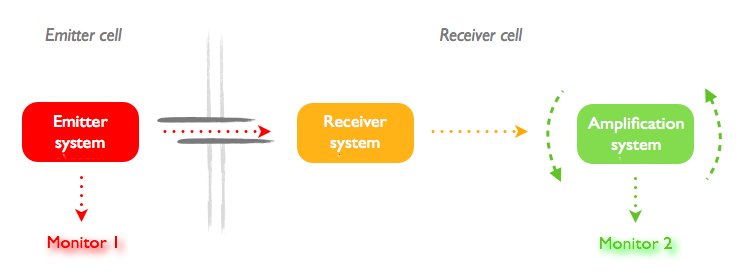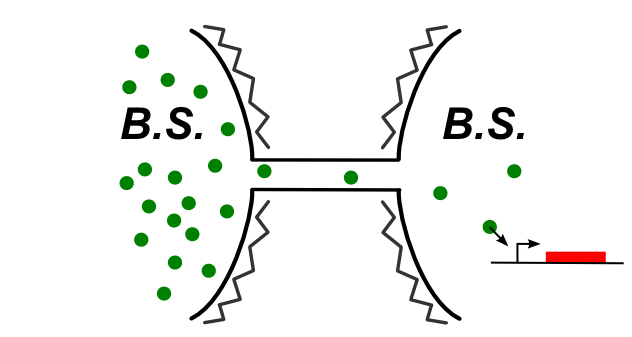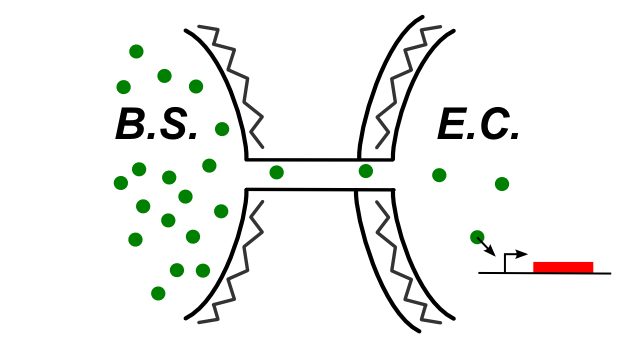Team:Paris Bettencourt/Designs
From 2011.igem.org
m |
|||
| Line 17: | Line 17: | ||
<h2>Main questions</h2> | <h2>Main questions</h2> | ||
| - | <p>The nanotube discovery is very recent. Though lots of questions remain unsolved concerning the mechanisms behind<em>the formation of the tubes</em>, the efficiency of the communication, the extent of the process. The existence of the tubes themselves remains a subject of controversy within the scientific community.</p> | + | <p>The nanotube discovery is very recent. Though lots of questions remain unsolved concerning the mechanisms behind <em>the formation of the tubes</em>, the efficiency of the communication, the extent of the process. The existence of the tubes themselves remains a subject of controversy within the scientific community.</p> |
<p>We aim to bring additional proof of their existence and better characterize the extent of this phenomenon. Here is the list of the questions we have been asking ourselves, and that our designs aim to answer:<p> | <p>We aim to bring additional proof of their existence and better characterize the extent of this phenomenon. Here is the list of the questions we have been asking ourselves, and that our designs aim to answer:<p> | ||
| Line 30: | Line 30: | ||
<li>What is the <em>nature</em> of the process? (passive or active transport)</li> | <li>What is the <em>nature</em> of the process? (passive or active transport)</li> | ||
<li>What kinds of molecules can pass through the nanotubes?</li> | <li>What kinds of molecules can pass through the nanotubes?</li> | ||
| - | <li>Does the communication happen only between B. subtilis? E. coli? or does the communication also exist between different species?</li> | + | <li>Does the communication happen only between <i>B. subtilis? E. coli? </i>or does the communication also exist between different species?</li> |
<li>If a communication is established with the Gram negative bacteria, is the communication happening through the periplasm or the cytoplasm?</li> | <li>If a communication is established with the Gram negative bacteria, is the communication happening through the periplasm or the cytoplasm?</li> | ||
</ul> | </ul> | ||
| Line 77: | Line 77: | ||
<th style="text-align:center;"><b><u>Description</u></b></th> | <th style="text-align:center;"><b><u>Description</u></b></th> | ||
<th style="width:100px;text-align:center;"><b><u>Type of switch</u></b></th> | <th style="width:100px;text-align:center;"><b><u>Type of switch</u></b></th> | ||
| - | <th style="width:100px;text-align:center;"><b><u>B. subilis<br/>E. coli<br/>compatibility</u></b></th> | + | <th style="width:100px;text-align:center;"><b><u><i>B. subilis<br/>E. coli<br/></i>compatibility</u></b></th> |
</tr> | </tr> | ||
| Line 101: | Line 101: | ||
<td style="text-align:center"><a href="https://2011.igem.org/Team:Paris_Bettencourt/SinOp"><img style="width:150px; margin-top:20px;" src="https://static.igem.org/mediawiki/2011/a/aa/SinOp-button.png"></a> | <td style="text-align:center"><a href="https://2011.igem.org/Team:Paris_Bettencourt/SinOp"><img style="width:150px; margin-top:20px;" src="https://static.igem.org/mediawiki/2011/a/aa/SinOp-button.png"></a> | ||
</td> | </td> | ||
| - | <td><em><a href="https://2011.igem.org/Team:Paris_Bettencourt/SinOp">KinA diffusion:</em></a> The Sin operon system controls the sporulation switch of B. subtilis. Making it diffuse from a non sporulating strain to a receiver cell makes the receiver cell to sporulate. | + | <td><em><a href="https://2011.igem.org/Team:Paris_Bettencourt/SinOp">KinA diffusion:</em></a> The Sin operon system controls the sporulation switch of <i>B. subtilis</i>. Making it diffuse from a non sporulating strain to a receiver cell makes the receiver cell to sporulate. |
</td> | </td> | ||
<td style="text-align:center;">Switch</td> | <td style="text-align:center;">Switch</td> | ||
| Line 142: | Line 142: | ||
<h2>Others designs we had no time to build</h2> | <h2>Others designs we had no time to build</h2> | ||
| - | <p>We neither had time nor the manpower to try all the ideas we had. In particular, we have designed some systems in order to investigate the E. coli / B. subtilis connection nature. He had no time to investigate this question further. Nonetheless, we present some of our design ideas for solving this problem in this section.</p> | + | <p>We neither had time nor the manpower to try all the ideas we had. In particular, we have designed some systems in order to investigate the <i>E. coli / B. subtilis</i> connection nature. He had no time to investigate this question further. Nonetheless, we present some of our design ideas for solving this problem in this section.</p> |
<p><i>B.subtilis</i> is Gram- so the nanotubes seem to create a link from the cytoplasm of the first cell to the cytoplasm of the second cell. In the case of the Gram+ bacteria, like<i> E.coli</i>, we wonder which membrane forms the nanotubes . Do they create a link with the periplasm, or with the cytoplasm? To test the two hypotheses, we tried to create a design for each of the two possibilities. If one work and the other does not, the answer to this question will be known.</p> | <p><i>B.subtilis</i> is Gram- so the nanotubes seem to create a link from the cytoplasm of the first cell to the cytoplasm of the second cell. In the case of the Gram+ bacteria, like<i> E.coli</i>, we wonder which membrane forms the nanotubes . Do they create a link with the periplasm, or with the cytoplasm? To test the two hypotheses, we tried to create a design for each of the two possibilities. If one work and the other does not, the answer to this question will be known.</p> | ||
| Line 148: | Line 148: | ||
<h3>Design for <i>B.subtilis / E. coli</i> if the connection happens with the cytoplasm</h3> | <h3>Design for <i>B.subtilis / E. coli</i> if the connection happens with the cytoplasm</h3> | ||
| - | <p>If the connection between E. coli and B. subtilis is happening through the cytoplasm, the type of connection could be summed up by the following schematic.</p> | + | <p>If the connection between <i>E. coli</i> and <i>B. subtilis</i> is happening through the cytoplasm, the type of connection could be summed up by the following schematic.</p> |
<img src="../wiki/images/3/3a/Cytoplasm_connection_with_coli.jpg" style="width: 500px; margin-left: 185px;"> | <img src="../wiki/images/3/3a/Cytoplasm_connection_with_coli.jpg" style="width: 500px; margin-left: 185px;"> | ||
Revision as of 15:59, 5 October 2011

Designs overview
Introduction
|
Our goal for this summer is to characterize the travel of various molecules through nanotubes. In order to do so, we want to develop several designs. In this page, we explain the principle of the different designs we have built. In the original paper [1], the authors directly observed the passage of molecules through the nanotubes. The idea behind our approach is to use synthetic biology methods to improve the sensitivity and the resolution of these experiments. Relying on signal amplification methods and natural, as well as artificial, bistable switches, we want to detect, with a resolution at the molecular level, the passage from one emittor cell to the receiver. |
 |
Main questions
The nanotube discovery is very recent. Though lots of questions remain unsolved concerning the mechanisms behind the formation of the tubes, the efficiency of the communication, the extent of the process. The existence of the tubes themselves remains a subject of controversy within the scientific community.
We aim to bring additional proof of their existence and better characterize the extent of this phenomenon. Here is the list of the questions we have been asking ourselves, and that our designs aim to answer:

|
|
Specification of our designs
We started designing the project with these previously stated questions in mind. Using several molecules of different sizes and nature, from a T7 polymerase to a tRNA amber suppressor, we aim to test the capacity and size limit for the molecules that can pass through the tubes. If the nature of movement is passive, the speed of the the movement should be proportional to the diffusion coefficient D, that is to say inversely proportional to the radius of the object. Can we design a system that would allow us to measure this speed of diffusion?
We decided that our constructs should follow the global idea summed up in the following scheme:
The problem is that each design needs a different couple of signal emitter/receptor. However, even with good models, the response time cannot be predicted easily because little is known about the transfer through the nanotubes. We tried to limit the impact of this issue by the following measures:
- Use each time the same actuator and the same monitor to have comparable response times in the different systems.
- The relevant measure is not the response time itself, but the increase of response time when the two constructs are in the same cell or in different cells linked by a nanotube
The idea is if we can measure this increase of time for different sizes, that is to say of different D coefficients, of the molecule we should get a relation in lambda/D, the diffusion is an active process. Else, the process is active. See the modeling pages for more details about this assumption.
In B.subtilis, nanotubes are reported to be formed by the cytoplasm. We had to find a molecule that can be expressed in the first cell that can trigger a genetic circuit in the second cell. The image below illustrates the idea:

Building fast new genetic devices
Using these specifications, we designed several sensitive genetic circuits that can be trigerred by molecules of various sizes. The molecules chosen cover 2 orders of magnitude of Radius. Here, they are classified from the biggest to the smallest.
| Description | Type of switch | B. subilis E. coli compatibility |
|
|---|---|---|---|

|
T7 polymerase diffusion: The T7 RNA polymerase is the RNA polymerase of the T7 phage. This is a big molecule, that recognizes a very specific promoter orthogonal to B.subtilis. | Irreversible amplification |
Yes |

|
Amber suppressor tRNA diffusion: The principle of this design is to produce in one cell an amber supressor tRNA that will diffuse through the nanotubes. The receptor cell holds the gene for T7 with amber stop codons that cannot be translated into a functional protein as long as the tRNA amber suppressor is not present in the cell. Once expressed, the functional amber T7 RNA polymerase will trigger the T7 amplification system. | Irreversible amplification |
Yes |

|
KinA diffusion: The Sin operon system controls the sporulation switch of B. subtilis. Making it diffuse from a non sporulating strain to a receiver cell makes the receiver cell to sporulate. | Switch | Mono- directional |
Lambda switch
|
Lambda switch design: The CI is a regulation protein from the lambda phage switch. Make it diffuse would change the state of the toogle switch from the push-on push-off system, from the PKU 2007. | Switch | Mono- directional |

|
The YFP-TetR/TetO array experiment: This experiment is an improvement of the previous one. To observe significant fluorescence in the neighboring cells, lots of molecules have to pass through the tubes. Using the affinity of the TetR for the TetO array, we want to concentrate at one point the YFP molecules to better observe this diffusion. | - | Yes |

|
ComS diffusion: ComS is an inhibitor of the MecA protease in B.subtilis. It plays a key role in the triggering of the competence and sporulation mechanisms. The idea is to trigger the switch of the MeKS system of the receptor cell by diffusing ComS through the nanotubes. A major precaution is to prevent the first cell from sporulating. | Switch | Mono- directional |
Others designs we had no time to build
We neither had time nor the manpower to try all the ideas we had. In particular, we have designed some systems in order to investigate the E. coli / B. subtilis connection nature. He had no time to investigate this question further. Nonetheless, we present some of our design ideas for solving this problem in this section.
B.subtilis is Gram- so the nanotubes seem to create a link from the cytoplasm of the first cell to the cytoplasm of the second cell. In the case of the Gram+ bacteria, like E.coli, we wonder which membrane forms the nanotubes . Do they create a link with the periplasm, or with the cytoplasm? To test the two hypotheses, we tried to create a design for each of the two possibilities. If one work and the other does not, the answer to this question will be known.
Design for B.subtilis / E. coli if the connection happens with the cytoplasm
If the connection between E. coli and B. subtilis is happening through the cytoplasm, the type of connection could be summed up by the following schematic.

In this case, be can re-use most of the designs of the first section (see the compatibility column). We also have proposed this design:
- Xis protein diffusion: Xis is a small partner of an excisase. The latter will excise a stop codon on the DNA strand that is preventing the expression of the GFP. We had no time to build this design, but the idea is summed up on the linked page.
Design for B.subtilis / E. coli if the connection happens with the periplasm
In case the communication happens with the periplasm, we have to think about molecules that can be then transported into the cytoplasm.

We had to design more sophisticated approaches. The ideas are the following:
- MBP diffusion: we need a CRP+, MBP- E.coli mutant. We produce the MBP protein in B.subtilis and make it diffuse through the nanotubes. As long as the MBP has not reached the periplasm of E.coli, the cell cannot digest the maltose in the medium. The indirect induction of MalR by MBP triggers the expression of the GFP reporter.
Can we conclude on these designs?
If one of these designs works, it will be proved that the inter-species nanotube communication exists and this will eventually show location of the connection with the membrane. There was limited time to test these designs but we propose them for future iGEM teams to investigate.
References
- Intercellular Nanotubes Mediate Bacterial Communication, Dubey and Ben-Yehuda, Cell, available here
 "
"


